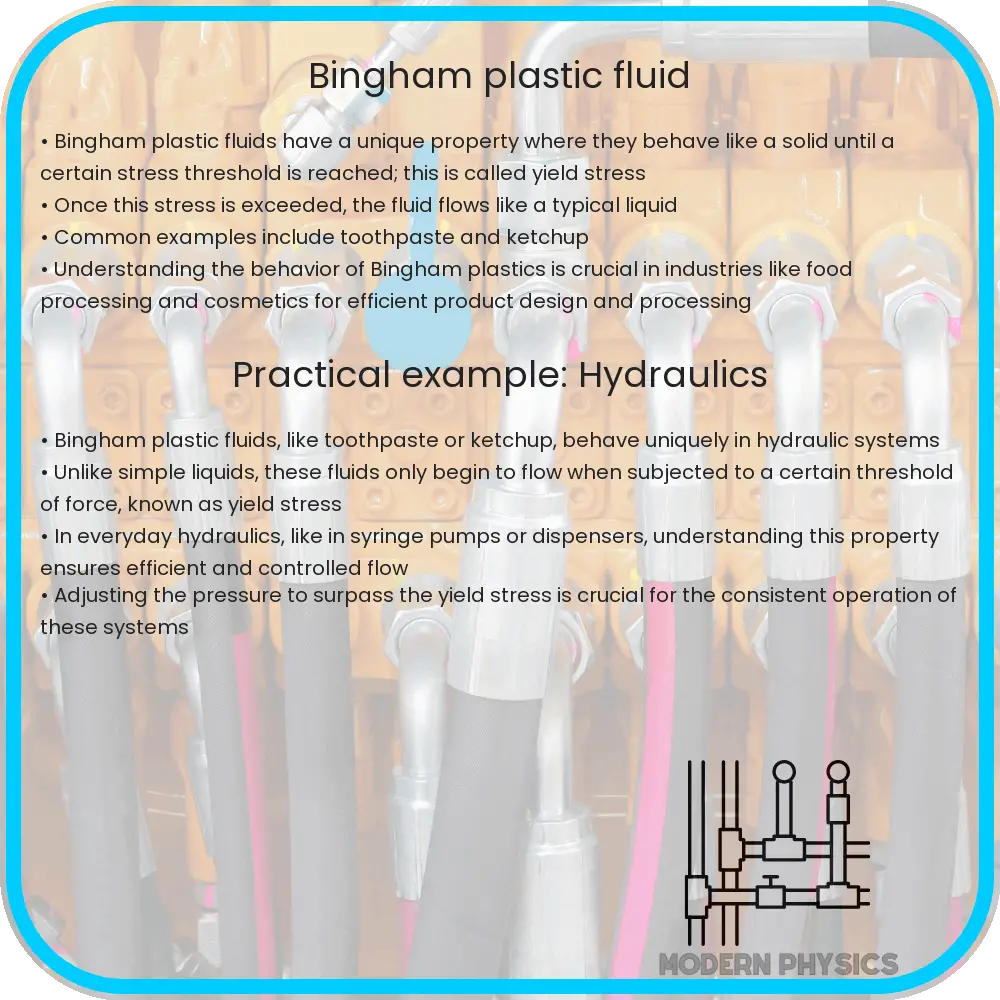Explore the intriguing world of Bingham Plastic Fluids, their rheology, yield stress, and viscosity, and their impact across various industries.

Understanding Bingham Plastic Fluid: Rheology, Yield Stress, and Viscosity
Bingham Plastic Fluids represent a unique category in the rheology of materials, often characterized by their distinct flow behavior that sets them apart from Newtonian fluids like water or non-Newtonian fluids such as ketchup. This article delves into the fundamental properties of Bingham Plastic Fluids, focusing on their rheology, yield stress, and viscosity.
Rheology of Bingham Plastic Fluids
Rheology, the study of flow and deformation of matter, plays a critical role in understanding Bingham Plastic Fluids. Unlike Newtonian fluids, which maintain a constant viscosity regardless of applied stress, Bingham Plastic Fluids exhibit a more complex relationship between stress and strain rate.
At the heart of their rheological behavior is the concept of yield stress. Bingham Plastic Fluids remain solid-like under a certain level of stress. Only when this threshold, known as the yield stress, is exceeded do they begin to flow like liquids. This characteristic makes them particularly useful in applications where controlled flow is essential, such as in the construction or food industries.
Yield Stress in Bingham Plastic Fluids
The yield stress is a defining feature of Bingham Plastic Fluids. It’s the minimum stress required to initiate flow. Below this threshold, the fluid behaves more like a solid, maintaining its shape and resisting deformation. This property is quantitatively expressed as a stress value (σy), which varies depending on the fluid’s composition and temperature.
Yield stress can be measured using rheometers, which apply varying levels of stress to a fluid sample and measure the resulting strain or flow. Understanding the yield stress is crucial for applications where precise flow control is necessary, such as in the formulation of paints or the transportation of slurries in mining operations.
Viscosity of Bingham Plastic Fluids
Once the yield stress is surpassed, Bingham Plastic Fluids start to flow, exhibiting a linear relationship between shear stress and shear rate. This post-yield behavior is where viscosity comes into play. The viscosity (η) of Bingham Plastic Fluids is defined by the slope of the stress-strain curve beyond the yield point.
Unlike Newtonian fluids, the viscosity of Bingham Plastic Fluids is not constant and depends on the rate of shear. This means that their flow characteristics can be fine-tuned by adjusting the shear rate, making them highly adaptable for various industrial processes.
Additionally, the temperature can significantly impact the viscosity of Bingham Plastic Fluids. As temperature increases, the internal structure of these fluids changes, typically resulting in a decrease in viscosity. This aspect is vital in industries like oil and gas, where fluids are often subjected to varying temperature conditions.
Understanding the interplay between yield stress and viscosity is essential for effectively utilizing Bingham Plastic Fluids in various applications. Their unique properties offer advantages in situations where precise control over fluid flow is required, whether in manufacturing, construction, or other industrial sectors.
In the following section, we will explore the practical applications of Bingham Plastic Fluids, their challenges in real-world scenarios, and the future advancements in this field.
Practical Applications and Challenges of Bingham Plastic Fluids
Bingham Plastic Fluids find widespread applications across various industries due to their unique flow characteristics. In construction, they are used in cement and concrete formulations, where controlled flow and stability are paramount. The food industry utilizes these fluids in products like mayonnaise and sauces, which need to maintain shape until disturbed. In the oil and gas sector, drilling muds often exhibit Bingham Plastic behavior, providing the necessary viscosity to carry drill cuttings to the surface while maintaining stability under static conditions.
However, working with Bingham Plastic Fluids also presents challenges. The precise determination of yield stress is crucial yet can be complex, as it depends on factors like temperature and composition. Additionally, maintaining consistent flow properties in large-scale industrial processes can be difficult due to the sensitivity of these fluids to external conditions.
Future Advancements and Conclusion
Advancements in the study and application of Bingham Plastic Fluids are ongoing. Researchers are continually developing more accurate models to predict flow behavior under various conditions, enhancing the practicality of these fluids in industrial applications. Technological improvements in rheometers and other measurement devices also contribute to a better understanding and control of these materials.
The environmental impact of Bingham Plastic Fluids, particularly in the oil and gas industry, is another area of focus. Developing eco-friendly formulations that maintain the desired rheological properties is crucial for sustainable practices.
In conclusion, Bingham Plastic Fluids, with their unique rheological properties, are vital in numerous industrial applications. Understanding their yield stress and viscosity is key to harnessing their full potential. While challenges exist, particularly in measurement and environmental impact, ongoing research and technological advancements continue to broaden their applicability and efficiency. As industries evolve, the role of Bingham Plastic Fluids is likely to expand, underscoring their significance in the modern technological landscape.
